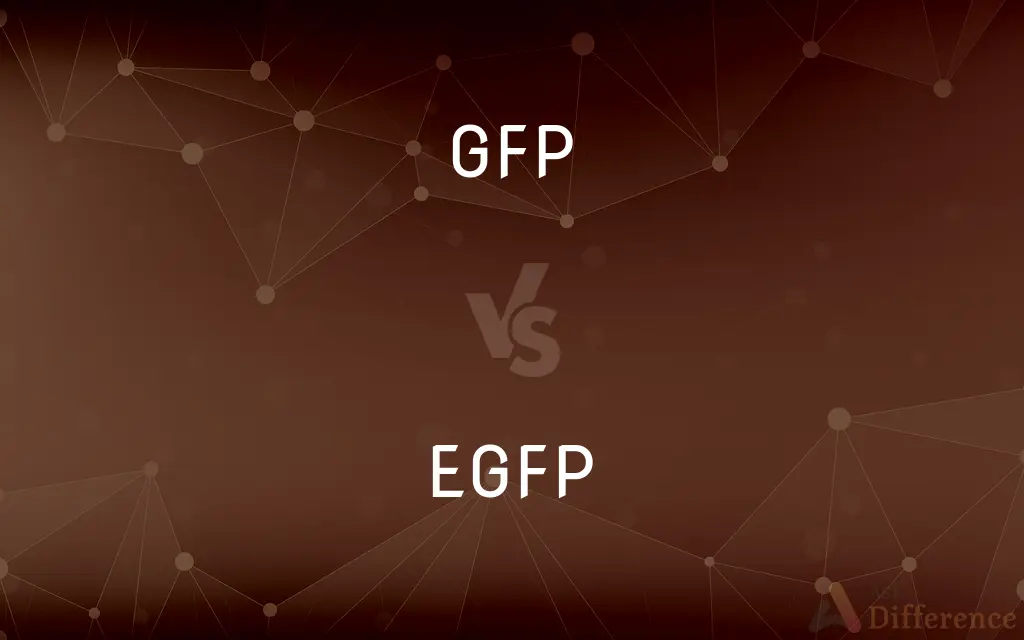GFP vs. EGFP — What's the Difference?
Edited by Tayyaba Rehman — By Fiza Rafique — Published on December 12, 2023
GFP stands for Green Fluorescent Protein, originally from a jellyfish; EGFP is an Enhanced version of GFP, optimized for brighter fluorescence in cells.

Difference Between GFP and EGFP
Table of Contents
ADVERTISEMENT
Key Differences
GFP, or Green Fluorescent Protein, has played a transformative role in biological research. Derived originally from the jellyfish Aequorea victoria, GFP exhibits natural fluorescence when exposed to UV or blue light. This unique feature allows scientists to use GFP as a marker to visualize and track proteins, cells, and even whole organisms. The discovery and application of GFP in molecular biology have revolutionized the way scientists study cellular and molecular processes.
EGFP, which stands for Enhanced Green Fluorescent Protein, is a modified version of GFP. It has been optimized to produce brighter fluorescence, especially in mammalian cells. The term "enhanced" in EGFP denotes the molecular adjustments that have been introduced to improve its fluorescence properties, making it a more effective marker in many experimental settings. While GFP has been groundbreaking, the advent of EGFP made fluorescence studies even more versatile.
Both GFP and EGFP are employed in a variety of scientific experiments. GFP serves as the foundation, the prototype from which other fluorescent proteins, including EGFP, were developed. The primary motive behind creating versions like EGFP was to tackle some limitations of GFP, such as its relatively low fluorescence in certain cellular environments.
EGFP's brighter fluorescence allows for clearer visualization in cellular structures, providing researchers with improved tools for their experiments. However, choosing between GFP and EGFP is based on the specific requirements of an experiment. While GFP remains valuable for numerous applications, EGFP is chosen for cases where enhanced visibility is crucial.
Despite the differences, the core function of both GFP and EGFP remains the same: to act as luminescent markers, aiding researchers in tracking and understanding biological processes. The development and refinement of these tools underscore the ever-evolving nature of scientific exploration.
ADVERTISEMENT
Comparison Chart
Origin
Derived from the jellyfish Aequorea victoria
Modified version of GFP
Brightness
Standard fluorescence
Brighter fluorescence
Modifications
Original sequence
Molecular adjustments for enhanced properties
Primary Use
Marker in biological studies
Marker in experiments needing brighter fluorescence
Performance in Cells
Good fluorescence but can be suboptimal in certain settings
Optimized for superior fluorescence in mammalian cells
Compare with Definitions
GFP
A naturally occurring fluorescent molecule.
Under UV light, GFP emits a green glow.
EGFP
A modified version of GFP with brighter fluorescence.
EGFP is preferred when enhanced visualization is required.
GFP
A tool in cell biology and neuroscience for visualization.
By attaching GFP to a specific protein, its pathway can be illuminated.
EGFP
Optimized for performance in mammalian cells.
Researchers use EGFP to study gene expression in mice.
GFP
A molecular marker in biological experiments.
With GFP, tracking protein movement in a cell becomes feasible.
EGFP
A result of molecular adjustments to GFP.
EGFP was developed to overcome some limitations of GFP.
GFP
A groundbreaking discovery in molecular biology.
The researchers who identified GFP's potential won a Nobel Prize.
EGFP
A testament to the evolution of fluorescence tools in science.
EGFP represents the advancement in fluorescence-based research methods.
GFP
A protein from the jellyfish Aequorea victoria that fluoresces green.
Scientists use GFP to label cells and observe their behavior.
EGFP
A tool for clearer visualization in biological experiments.
Cellular structures are more distinct with EGFP markers.
Common Curiosities
What does GFP stand for?
GFP stands for Green Fluorescent Protein.
Why was EGFP developed?
EGFP was developed to address some limitations of GFP, especially in mammalian cells.
And EGFP?
EGFP stands for Enhanced Green Fluorescent Protein.
How is EGFP different from GFP?
EGFP is a modified version of GFP, optimized for brighter fluorescence.
Where does GFP originally come from?
GFP is derived from the jellyfish Aequorea victoria.
Is the purpose of GFP and EGFP the same?
Yes, both serve as fluorescent markers in biological research, but EGFP offers enhanced brightness.
Are there other fluorescent proteins besides GFP and EGFP?
Yes, there are multiple variants, including those that fluoresce in different colors.
Can GFP and EGFP be seen under normal light?
No, they fluoresce under UV or blue light.
Is EGFP naturally occurring?
No, EGFP is a result of molecular modifications to the original GFP.
Why is EGFP's fluorescence brighter?
Molecular adjustments were made to EGFP to enhance its fluorescence properties.
Share Your Discovery

Previous Comparison
Convergent Evolution vs. Divergent Evolution
Next Comparison
Pooling of Interest Method vs. Purchase MethodAuthor Spotlight
Written by
Fiza RafiqueFiza Rafique is a skilled content writer at AskDifference.com, where she meticulously refines and enhances written pieces. Drawing from her vast editorial expertise, Fiza ensures clarity, accuracy, and precision in every article. Passionate about language, she continually seeks to elevate the quality of content for readers worldwide.
Edited by
Tayyaba RehmanTayyaba Rehman is a distinguished writer, currently serving as a primary contributor to askdifference.com. As a researcher in semantics and etymology, Tayyaba's passion for the complexity of languages and their distinctions has found a perfect home on the platform. Tayyaba delves into the intricacies of language, distinguishing between commonly confused words and phrases, thereby providing clarity for readers worldwide.












































